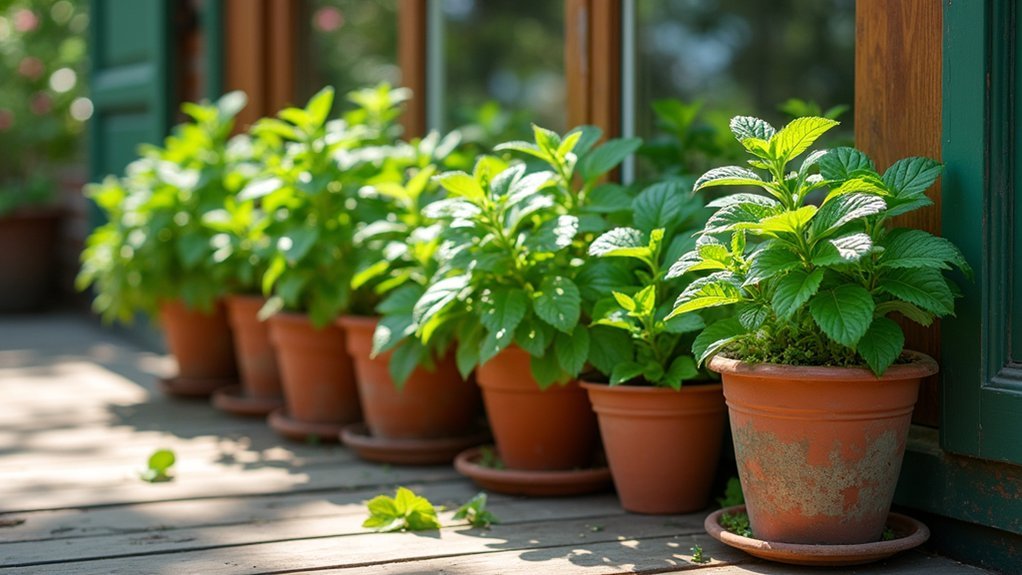Mint effectively repels ants through compounds that disrupt their communication systems. You’ll get best results by creating a peppermint spray (5% oil concentration with water and dish soap) and applying it every 3-5 days along entry points and ant trails. Place potted mint plants strategically around doorways and windowsills for additional protection. Always clean surfaces before application to remove existing pheromone trails. These natural barriers create invisible boundaries ants won’t cross—and proper maintenance guarantees lasting protection.
Why Mint Works: Understanding Its Natural Repellent Properties

Three powerful compounds in mint create its renowned ant-repelling properties. These natural chemicals produce a strong aroma that effectively disrupts ants’ sophisticated communication systems, making it nearly impossible for them to follow their pheromone trails.
When you place mint around your home, you’re creating an invisible barrier that confuses these persistent pests.
Essential oils extracted from mint, especially peppermint, have demonstrated up to 56% effectiveness against ant activity in field tests. The scent that’s pleasant to you is actually offensive to many ant species, causing them to avoid treated areas altogether.
Peppermint’s potent oils create an aromatic fortress, turning your pleasant home scent into an ant’s worst nightmare.
For maximum effectiveness, strategically position chopped mint leaves or essential oils near entry points and along known ant pathways. This natural deterrent not only repels ants but also enhances your home with a fresh fragrance.
Creating Potent Mint Spray Barriers for Immediate Protection
You’ll need just three simple ingredients—peppermint essential oil, water, and dish soap—to create a powerful ant-repelling mint spray barrier.
Apply your homemade solution generously along windowsills, doorways, and any visible ant trails, focusing on entry points where the pests typically invade.
For maximum effectiveness, don’t forget to reapply every few days and place mint-soaked cotton balls as additional barriers in problem areas.
Mint Spray Recipe
Creating a potent mint spray barrier takes just three simple ingredients that pack a powerful punch against invading ants. Mix 15-20 drops of peppermint essential oil with 1 cup of water and add 1-2 teaspoons of dish soap to help the oil disperse properly.
This homemade mint spray serves as a non-toxic alternative to chemical repellents, keeping your family safe while you keep ants away.
To maximize effectiveness:
- Shake the mixture well before each application
- Apply along entry points, windowsills, and visible ant trails
- Reapply every 2-3 days to maintain the protective barrier
For added protection, soak cotton balls in your mint spray solution and place them strategically at ant entry points. This natural method is completely safe around children and pets.
Application Techniques
Once you’ve prepared your mint spray solution, proper application techniques will determine how effectively it repels ants from your home.
Shake your spray bottle vigorously before each use to properly emulsify the peppermint oil with the water and soap mixture.
Focus your application on two key areas: entry points where ants access your home and visible ant trails they’ve established.
Before spraying, clean surfaces thoroughly to remove existing pheromone trails, which will enhance the repellent effect. Apply with generous coverage, ensuring all target areas are treated.
For longer-lasting protection, consider soaking cotton balls in your mint spray and placing them near entry points. These can remain effective for several days.
Remember to reapply your peppermint solution every 2-3 days, as its repellent properties naturally diminish over time.
Strategic Placement of Potted Mint Plants Around Your Home

While chemical repellents often come with harsh odors and potential toxicity, strategically positioned mint plants offer a natural and pleasant-smelling alternative to keep ants at bay.
Placing potted mint around key entry points creates an effective natural barrier that deters ants, as they strongly dislike mint’s potent scent.
For maximum effectiveness, consider these strategic placement options:
- Position potted mint directly on windowsills and beside doorways to disrupt ant trails before they form.
- Create perimeter protection by placing plants every few feet around your home’s foundation.
- Extend your defense to outdoor areas like patios and decks where ant activity often begins.
Refreshing Mint Barriers: Maintenance Schedule for Maximum Effectiveness
Even the most potent mint barriers require regular rejuvenation to maintain their ant-repelling power. For peak protection, reapply your homemade mint barriers every 2-3 days as their scent fades and ants adapt to their presence.
Before application, clean surfaces thoroughly to eliminate existing ant pheromone trails. For barrier sprays, mix 15-20 drops of peppermint essential oil with 1 cup of water and 1-2 teaspoons of dish soap, then apply at entry points.
Replace peppermint-soaked cotton balls every 2-3 days to guarantee continuous repelling of ants along trails.
Monitor your barriers’ effectiveness and adjust as needed. For stubborn infestations, increase the concentration to 3-5% essential oil.
Following this maintenance schedule will maximize your mint barriers’ effectiveness, keeping your home ant-free throughout the season.
Combining Mint With Other Natural Repellents for Enhanced Results

Although mint barriers offer significant protection against ants, combining peppermint with complementary natural repellents creates a synergistic defense system that’s substantially more effective than using mint alone.
When you’re creating homemade mint barriers, consider these powerful combinations that disrupt ant scent trails.
- Mix 15-20 drops of peppermint oil with cinnamon oil in your barrier spray – the peppermint confuses ant navigation while cinnamon interferes with their pheromone trails.
- Enhance your mint solution with vinegar to create a more effective natural repellent that thoroughly disrupts ant communication systems.
- Create a triple-threat barrier using crushed mint leaves, diatomaceous earth, and citrus peels – this combination confuses ants, dehydrates them, and provides natural deterrence.
These effective natural combinations will strengthen your mint-based defense against persistent ant invasions.
Common Mistakes to Avoid When Using Mint as an Ant Deterrent
When creating mint barriers to repel ants, you’re likely to fail if you place mint leaves too far apart, creating gaps ants can easily navigate through.
Choosing dried mint over fresh can considerably reduce effectiveness, as fresh mint contains stronger oils that better deter ant invaders.
Your defense strategy will also crumble if you don’t maintain consistent application patterns, particularly around entry points and along known ant trails.
Mint Spacing Issues
While mint serves as an effective natural ant repellent, improper spacing can create more problems than it solves in your garden. Mint’s aggressive spreading tendency through rhizomes means you’ll need to carefully plan its placement, especially near entry points where ants typically invade.
To maintain mint as an effective deterrent without letting it take over:
- Plant in containers – Always use pots or buried barriers to control mint’s spread while preserving its ant-repelling properties.
- Maintain adequate spacing – Keep mint at least 2-3 feet from other plants and pathways to prevent encroachment.
- Observe and adjust – Different ant species respond differently to mint, so watch your specific ant population and adjust spacing accordingly.
Regular maintenance and proper spacing guarantee mint remains a helpful deterrent rather than a garden nuisance.
Fresh vs. Dried
The two biggest misconceptions about mint as an ant deterrent involve its freshness and potency.
While you might assume fresh mint leaves are superior for repelling ants, they quickly wilt and lose their aromatic properties, reducing their effectiveness as barriers against these persistent pests.
Dried mint presents its own challenges.
Though more convenient, dried leaves gradually lose their scent, requiring regular replacement to maintain any repellent qualities. Many homeowners are surprised when ants march undeterred past their carefully placed mint barriers.
For natural ant control that actually works, consider enhancing your mint strategy.
Combine dried mint with potent essential oils to create more effective deterrents. Always verify your mint is freshly harvested or properly stored to preserve its repelling properties, as the aromatic compounds are what truly keep ants at bay.
Inconsistent Application Patterns
Many homeowners sabotage their mint barriers before they’ve even begun working properly. Ants quickly adapt to inconsistent application of deterrents, rendering your efforts ineffective.
To maximize the repellent effect of your mint barriers:
- Apply consistently – Sporadic use allows ants to re-establish trails. Confirm mint scents are regularly reapplied every 3-5 days.
- Prepare properly – Clean surfaces thoroughly before application to remove existing pheromone trails that might overpower mint deterrents.
- Use concentrated solutions – Diluted mint oil (less than 3%) lacks efficacy. Create a stronger 3-5% solution for better results.
Remember to monitor your mint barriers regularly, replacing dried leaves and rejuvenating oil applications.
Consistency is key—even the most potent mint solution fails when applied haphazardly.
Frequently Asked Questions
How to Use Mint to Repel Ants?
You can repel ants with mint by scattering chopped leaves in ant-prone areas, spraying peppermint oil-water solution at entry points, placing soaked cotton balls along trails, or growing mint plants near doorways.
How Do You Make an Ant Barrier?
To make an ant barrier, mix peppermint oil, water, and dish soap in a spray bottle. Apply it around entry points and trails every few days. You’ll need to reapply regularly for continued protection.
What Is a Natural Ant Barrier?
A natural ant barrier is a non-toxic deterrent you’ll create using substances like essential oils, mint leaves, or vinegar that repels ants without harming your plants or pets. It disrupts their pheromone trails effectively.
What Smell Do Ants Hate the Most?
Ants hate clove oil the most, with 88% effectiveness as a repellent. You’ll also find they strongly dislike peppermint (56% effective), cinnamon, and citronella oils which disrupt their communication and navigation systems.
In Summary
You’ll find mint barriers offer a safe, natural way to keep ants at bay without harsh chemicals. Whether you’re spraying diluted mint oil, planting mint around entry points, or rejuvenating your barriers regularly, consistency is key. Don’t forget to combine mint with other natural repellents for maximum effectiveness, and avoid common pitfalls like insufficient concentration. With these strategies, you’re well-equipped to maintain an ant-free home naturally.





Leave a Reply